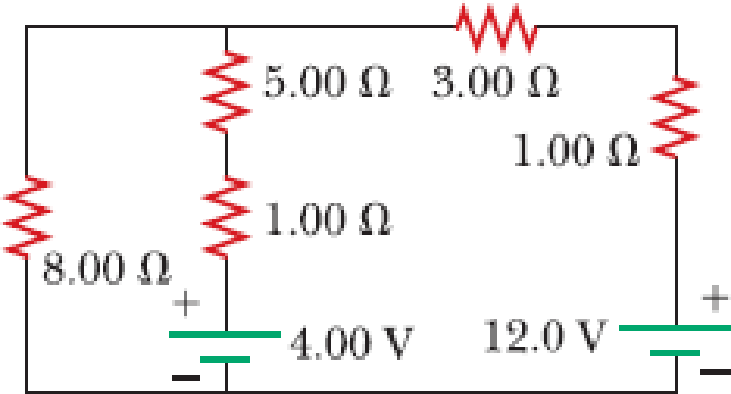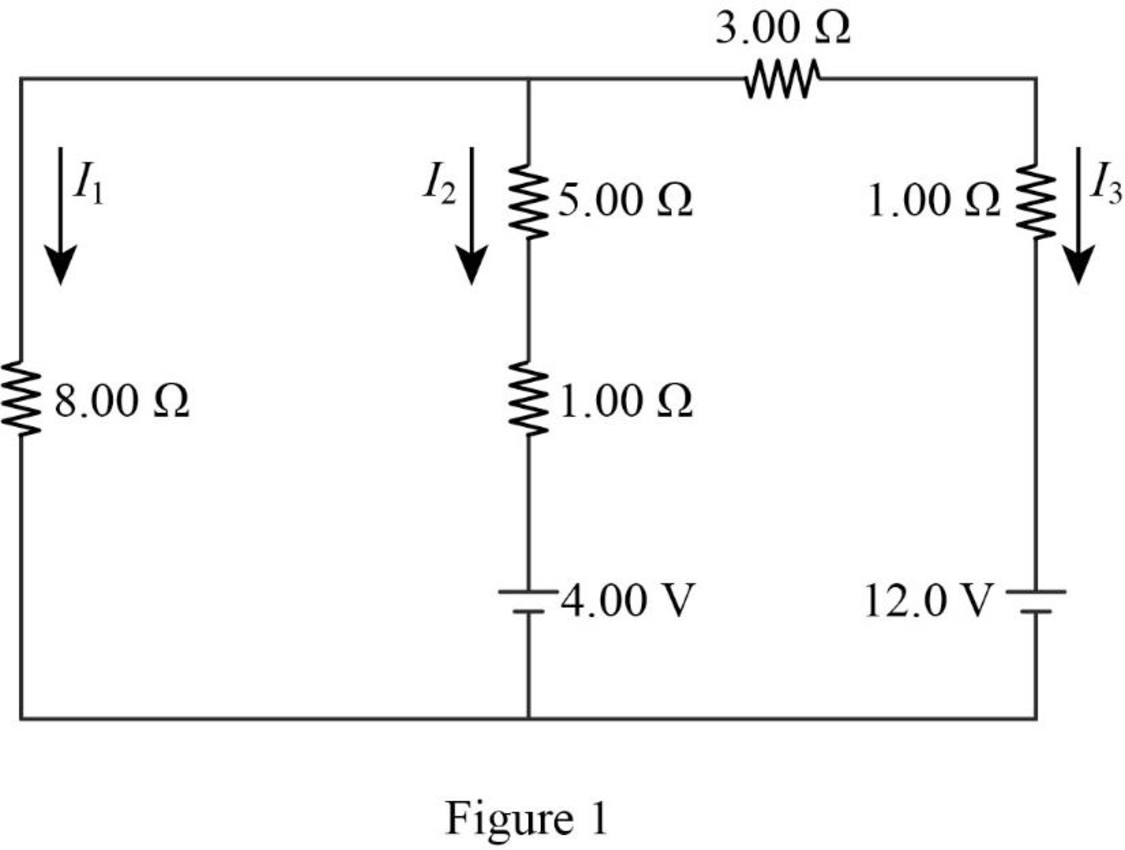
The circuit shown in Figure P21.47 is connected for 2.00 min. (a) Determine the current in each branch of the circuit. (b) Find the energy delivered by each battery. (c) Find the energy delivered to each resistor. (d) Identify the type of energy storage transformation that occurs in the operation of the circuit. (e) Find the total amount of energy transformed into internal energy in the resistors.
Figure P21.47 Problems 47 and 48.

(a)
The current in each branch of the circuit.
Answer to Problem 47P
The current
Explanation of Solution

Write the expression for the Kirchhoff’s loop rule in second loop from the left of the figure
Here,
Write the expression for the Kirchhoff’s loop rule in first loop from the left of the figure
Write the expression for the Kirchhoff’s junction rule in the figure
Use equation (III) in (I) and solve the equation.
Use equation (II) to solve for
Use equation (IV) in (V) to solve for
Use equation (VI) to solve for
Use equation (VII) in (V) to solve for
Use equation (VIII) and (VII)in (III) to solve for
Conclusion:
Therefore, the current
(b)
The energy delivered to each battery.
Answer to Problem 47P
The energy delivered to
Explanation of Solution
Write the expression for the energy delivered to the battery.
Here,
Write the expression for the
Here,
Use equation (XI) in (X) to solve for
Conclusion:
Substitute
Substitute
Therefore, the energy delivered to
(c)
The energy delivered to each resistor.
Answer to Problem 47P
The energy delivered to
Explanation of Solution
Write the expression for the energy delivered to the resistor.
Here,
Conclusion:
Substitute
Substitute
Substitute
Substitute
Substitute
Therefore, the energy delivered to
(d)
The type of energy transformation occurs in the operation of the circuit.
Answer to Problem 47P
The chemical energy is transformed to the internal energy in the resistors.
Explanation of Solution
The chemical energy in the
Conclusion:
Therefore, the chemical energy is transformed to the internal energy in the resistors.
(e)
The total amount of energy transformed into internal energy in the resistors.
Answer to Problem 47P
The total amount of energy transformed into internal energy in the resistors is
Explanation of Solution
Write the expression for the total amount of energy transformed into internal energy in the resistors.
Here,
Conclusion:
Substitute
Therefore, the total amount of energy transformed into internal energy in the resistors is
Want to see more full solutions like this?
Chapter 21 Solutions
Principles of Physics: A Calculus-Based Text, Hybrid (with Enhanced WebAssign Printed Access Card)
- Lab 8 Part 3 PHET Wave Interface simulation. I am having trouble with this part of the lab.arrow_forwardMick and Rick are twins born on Earth in the year 2175. Rick grows up to be an Earth-bound robotics technician while Mick becomes an intergalactic astronaut. Mick leaves the Earth on his first space mission in the year 2200 and travels, according to his clock, for 10 years at a speed of 0.75c. Unfortunately, at this point in his journey, the structure of his ship undergoes mechanical breakdown and the ship explodes. How old is Rick when his brother dies?arrow_forwardHi, I have canceled, why did you charge me again?arrow_forward
 Principles of Physics: A Calculus-Based TextPhysicsISBN:9781133104261Author:Raymond A. Serway, John W. JewettPublisher:Cengage Learning
Principles of Physics: A Calculus-Based TextPhysicsISBN:9781133104261Author:Raymond A. Serway, John W. JewettPublisher:Cengage Learning Physics for Scientists and Engineers with Modern ...PhysicsISBN:9781337553292Author:Raymond A. Serway, John W. JewettPublisher:Cengage Learning
Physics for Scientists and Engineers with Modern ...PhysicsISBN:9781337553292Author:Raymond A. Serway, John W. JewettPublisher:Cengage Learning
 Physics for Scientists and EngineersPhysicsISBN:9781337553278Author:Raymond A. Serway, John W. JewettPublisher:Cengage Learning
Physics for Scientists and EngineersPhysicsISBN:9781337553278Author:Raymond A. Serway, John W. JewettPublisher:Cengage Learning College PhysicsPhysicsISBN:9781305952300Author:Raymond A. Serway, Chris VuillePublisher:Cengage Learning
College PhysicsPhysicsISBN:9781305952300Author:Raymond A. Serway, Chris VuillePublisher:Cengage Learning College PhysicsPhysicsISBN:9781285737027Author:Raymond A. Serway, Chris VuillePublisher:Cengage Learning
College PhysicsPhysicsISBN:9781285737027Author:Raymond A. Serway, Chris VuillePublisher:Cengage Learning





